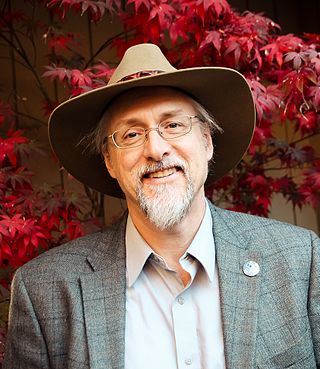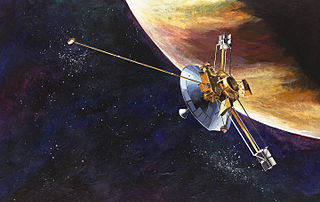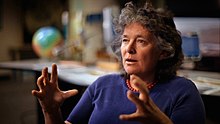
In astronomy and planetary science, a magnetosphere is a region of space surrounding an astronomical object in which charged particles are affected by that object's magnetic field. It is created by a celestial body with an active interior dynamo.

Harpalyke, also known as Jupiter XXII, is a retrograde irregular satellite of Jupiter. It was discovered by a team of astronomers from the University of Hawaii led by Scott S. Sheppard in 2000, and given the temporary designation S/2000 J 5. In August 2003, the moon was named after Harpalyke, the incestuous daughter of Clymenus, who in some accounts was also a lover of Zeus (Jupiter).

Praxidike, also known as Jupiter XXVII, is a retrograde irregular satellite of Jupiter. It was discovered by a team of astronomers from the University of Hawaii led by Scott S. Sheppard in 2000, and given the temporary designation S/2000 J 7.

Iocaste, also known as Jupiter XXIV, is a retrograde irregular satellite of Jupiter. It was discovered by a team of astronomers from the University of Hawaii including: David C. Jewitt, Yanga R. Fernandez, and Eugene Magnier led by Scott S. Sheppard in 2000, and given the temporary designation S/2000 J 3.

Marc William Buie is an American astronomer and prolific discoverer of minor planets who works at the Southwest Research Institute in Boulder, Colorado in the Space Science Department. Formerly he worked at the Lowell Observatory in Flagstaff, Arizona, and was the Sentinel Space Telescope Mission Scientist for the B612 Foundation, which is dedicated to protecting Earth from asteroid impact events.

The magnetosphere of Jupiter is the cavity created in the solar wind by Jupiter's magnetic field. Extending up to seven million kilometers in the Sun's direction and almost to the orbit of Saturn in the opposite direction, Jupiter's magnetosphere is the largest and most powerful of any planetary magnetosphere in the Solar System, and by volume the largest known continuous structure in the Solar System after the heliosphere. Wider and flatter than the Earth's magnetosphere, Jupiter's is stronger by an order of magnitude, while its magnetic moment is roughly 18,000 times larger. The existence of Jupiter's magnetic field was first inferred from observations of radio emissions at the end of the 1950s and was directly observed by the Pioneer 10 spacecraft in 1973.

The exploration of Jupiter has been conducted via close observations by automated spacecraft. It began with the arrival of Pioneer 10 into the Jovian system in 1973, and, as of 2023, has continued with eight further spacecraft missions in the vicinity of Jupiter. All of these missions were undertaken by the National Aeronautics and Space Administration (NASA), and all but two were flybys taking detailed observations without landing or entering orbit. These probes make Jupiter the most visited of the Solar System's outer planets as all missions to the outer Solar System have used Jupiter flybys. On 5 July 2016, spacecraft Juno arrived and entered the planet's orbit—the second craft ever to do so. Sending a craft to Jupiter is difficult, mostly due to large fuel requirements and the effects of the planet's harsh radiation environment.
Philip D. Nicholson is an Australian-born professor of astronomy at Cornell University in the Astronomy department specialising in Planetary Sciences. He was editor-in-chief of the journal Icarus between 1998 and 2018.

Louis John Lanzerotti is an American physicist. He is a Distinguished Research Professor of physics in the Center for Solar-Terrestrial Research at New Jersey Institute of Technology (NJIT) in Newark, New Jersey.

Margaret Galland Kivelson is an American space physicist, planetary scientist, and distinguished professor emerita of space physics at the University of California, Los Angeles. From 2010 to the present, concurrent with her appointment at UCLA, Kivelson has been a research scientist and scholar at the University of Michigan. Her primary research interests include the magnetospheres of Earth, Jupiter, and Saturn.
Bonnie J. Buratti is an American planetary scientist in the Division of Earth and Space Sciences at the Jet Propulsion Laboratory in Pasadena, California, where she leads the Comets, Asteroids, and Satellites Group. Her research involves the composition and physical properties of planetary surfaces, and volatile transport in the outer solar system.

Amanda R. Hendrix is an American planetary scientist known for her pioneering studies of solar system bodies at ultraviolet wavelengths. She is a senior scientist at the Planetary Science Institute. Her research interests include moon and asteroid surface composition, space weathering effects and radiation products. She is a co-investigator on the Cassini UVIS instrument, was a co-investigator on the Galileo UVS instrument, is a Participating Scientist on the Lunar Reconnaissance Orbiter LAMP instrument and is a Principal Investigator on Hubble Space Telescope observing programs. As of 2019, she is also the co-lead of the NASA Roadmaps to Oceans World Group.

Magnetometer (MAG) is an instrument suite on the Juno orbiter for planet Jupiter. The MAG instrument includes both the Fluxgate Magnetometer (FGM) and Advanced Stellar Compass (ASC) instruments. There two sets of MAG instrument suites, and they are both positioned on the far end of three solar panel array booms. Each MAG instrument suite observes the same swath of Jupiter, and by having two sets of instruments, determining what signal is from the planet and what is from spacecraft is supported. Avoiding signals from the spacecraft is another reason MAG is placed at the end of the solar panel boom, about 10 m and 12 m away from the central body of the Juno spacecraft.

Alexander J. Dessler was an American space scientist known for conceiving the term heliosphere and for founding the first Space Science Department in the United States.

Henry B. Throop, is an American astronomer and planetary scientist who specializes in the dynamics of rings and dust in the outer solar system. Throop is a member of the science team for NASA's New Horizons mission to Pluto and the Kuiper Belt, and has been involved with NASA missions throughout the solar system. Throop lives in Washington, DC where he runs NASA's science programs in the outer solar system. He has done extensive education and outreach around the world, having spent nearly a decade as an astronomer living in South Africa, India, and Mexico. The asteroid 193736 Henrythroop is named after him.

Amy Simon is an American planetary scientist at NASA's Goddard Space Flight Center, involved in several missions of the Solar System Exploration Program.

Emma J. Bunce is a British space physicist and Professor of Planetary Plasma Physics at the University of Leicester. She holds a Royal Society Wolfson Research Merit Award. Her research is on the magnetospheres of Saturn and Jupiter. She is principal investigator (PI) of the MIXS instrument on BepiColombo, was deputy lead on the Jupiter Icy Moons Explorer proposal, and co-investigator on the Cassini–Huygens mission.

Mei-Ching Hannah Fok is a planetary scientist at the Goddard Space Flight Center. She was awarded the NASA Exceptional Scientific Achievement Medal in 2011 and elected a Fellow of the American Geophysical Union in 2019. She has worked on the IMAGE, Van Allen Probes and TWINS missions.

Plasma Wave Subsystem, abbreviated PWS, is an instrument that is on board the Voyager 1 and Voyager 2 unmanned probes of the Voyager program. The device is 16 channel step frequency receiver and a low-frequency waveform receiver that can measure electron density. The PWS uses the two long antenna in a V-shape on the spacecraft, which are also used by another instrument on the spacecraft. The instrument recorded data about the Solar System's gas giants, and about the outer reaches of the Heliosphere, and beyond. In the 2010s, the PWS was used to play the "sounds of interstellar space" as the spacecraft can sample the local interstellar medium after they departed the Sun's heliosphere. The heliosphere is a region essentially under the influence of the Sun's solar wind, rather than the local interstellar environment, and is another way of understanding the Solar System in comparison to the objects gravitationally bound around Earth's Sun.

Sushil K. Atreya is a planetary scientist, educator, and researcher. Atreya is a professor of Climate and Space Sciences and Engineering at the University of Michigan, Ann Arbor.


















